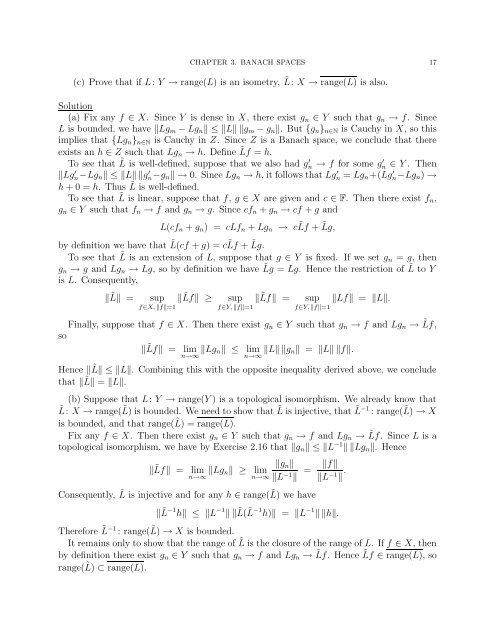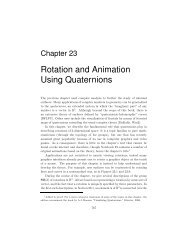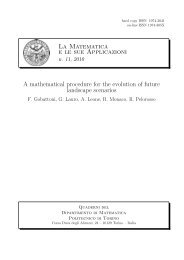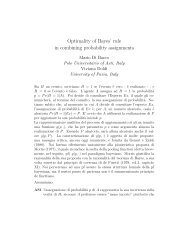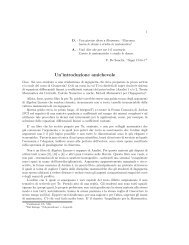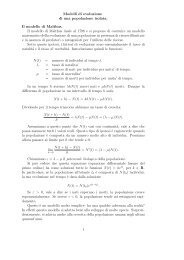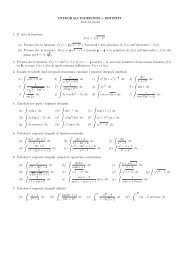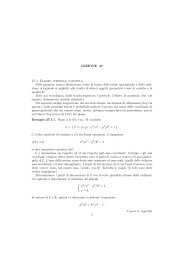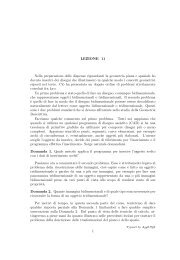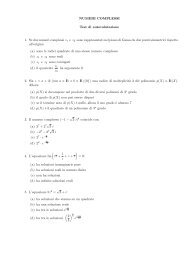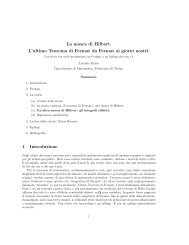FUNCTIONAL ANALYSIS LECTURE NOTES CHAPTER 3. BANACH ...
FUNCTIONAL ANALYSIS LECTURE NOTES CHAPTER 3. BANACH ...
FUNCTIONAL ANALYSIS LECTURE NOTES CHAPTER 3. BANACH ...
You also want an ePaper? Increase the reach of your titles
YUMPU automatically turns print PDFs into web optimized ePapers that Google loves.
<strong>CHAPTER</strong> <strong>3.</strong> <strong>BANACH</strong> SPACES 17<br />
(c) Prove that if L: Y → range(L) is an isometry, ˜ L: X → range(L) is also.<br />
Solution<br />
(a) Fix any f ∈ X. Since Y is dense in X, there exist gn ∈ Y such that gn → f. Since<br />
L is bounded, we have Lgm − Lgn ≤ L gm − gn. But {gn}n∈N is Cauchy in X, so this<br />
implies that {Lgn}n∈N is Cauchy in Z. Since Z is a Banach space, we conclude that there<br />
exists an h ∈ Z such that Lgn → h. Define ˜ Lf = h.<br />
To see that ˜ L is well-defined, suppose that we also had g ′ n → f for some g ′ n ∈ Y . Then<br />
Lg ′ n−Lgn ≤ L g ′ n−gn → 0. Since Lgn → h, it follows that Lg ′ n = Lgn+(Lg ′ n−Lgn) →<br />
h + 0 = h. Thus ˜ L is well-defined.<br />
To see that ˜ L is linear, suppose that f, g ∈ X are given and c ∈ F. Then there exist fn,<br />
gn ∈ Y such that fn → f and gn → g. Since cfn + gn → cf + g and<br />
L(cfn + gn) = cLfn + Lgn → c ˜ Lf + ˜ Lg,<br />
by definition we have that ˜ L(cf + g) = c ˜ Lf + ˜ Lg.<br />
To see that ˜ L is an extension of L, suppose that g ∈ Y is fixed. If we set gn = g, then<br />
gn → g and Lgn → Lg, so by definition we have ˜ Lg = Lg. Hence the restriction of ˜ L to Y<br />
is L. Consequently,<br />
˜ L = sup <br />
f∈X, f=1<br />
˜ Lf ≥ sup <br />
f∈Y, f=1<br />
˜ Lf = sup Lf = L.<br />
f∈Y, f=1<br />
Finally, suppose that f ∈ X. Then there exist gn ∈ Y such that gn → f and Lgn → ˜ Lf,<br />
so<br />
˜ Lf = lim<br />
n→∞ Lgn ≤ lim<br />
n→∞ L gn = L f.<br />
Hence ˜ L ≤ L. Combining this with the opposite inequality derived above, we conclude<br />
that ˜ L = L.<br />
(b) Suppose that L: Y → range(Y ) is a topological isomorphism. We already know that<br />
˜L: X → range( ˜ L) is bounded. We need to show that ˜ L is injective, that ˜ L −1 : range( ˜ L) → X<br />
is bounded, and that range( ˜ L) = range(L).<br />
Fix any f ∈ X. Then there exist gn ∈ Y such that gn → f and Lgn → ˜ Lf. Since L is a<br />
topological isomorphism, we have by Exercise 2.16 that gn ≤ L −1 Lgn. Hence<br />
˜ Lf = lim<br />
n→∞ Lgn ≥ lim<br />
n→∞<br />
gn<br />
L −1 <br />
Consequently, ˜ L is injective and for any h ∈ range( ˜ L) we have<br />
= f<br />
L −1 .<br />
˜ L −1 h ≤ L −1 ˜ L( ˜ L −1 h) = L −1 h.<br />
Therefore ˜ L −1 : range( ˜ L) → X is bounded.<br />
It remains only to show that the range of ˜ L is the closure of the range of L. If f ∈ X, then<br />
by definition there exist gn ∈ Y such that gn → f and Lgn → ˜ Lf. Hence ˜ Lf ∈ range(L), so<br />
range( ˜ L) ⊂ range(L).


